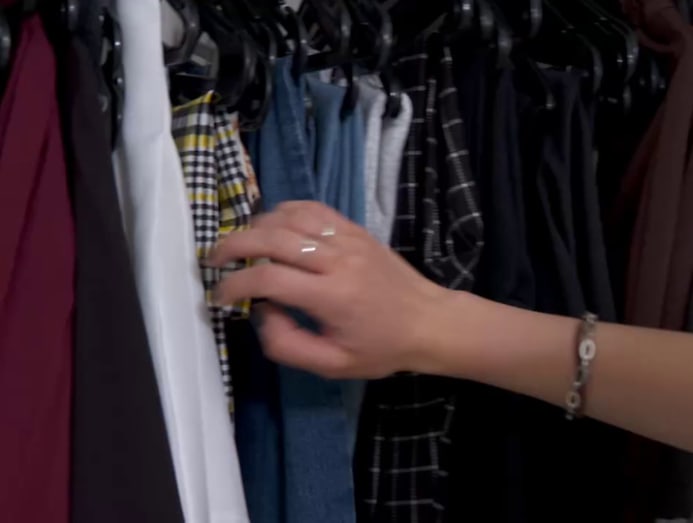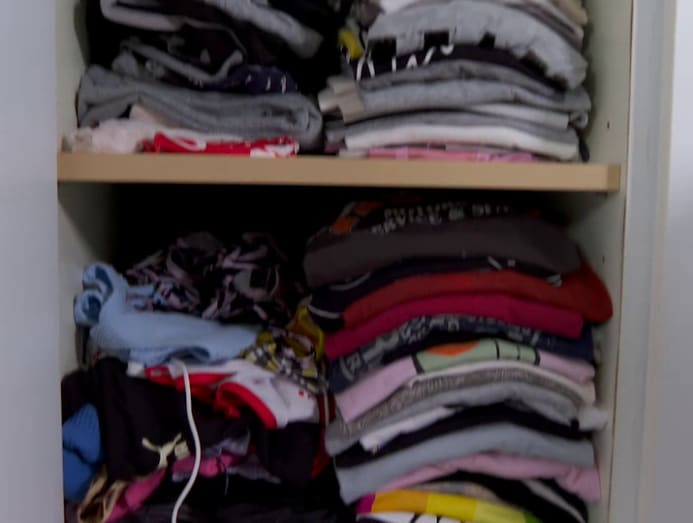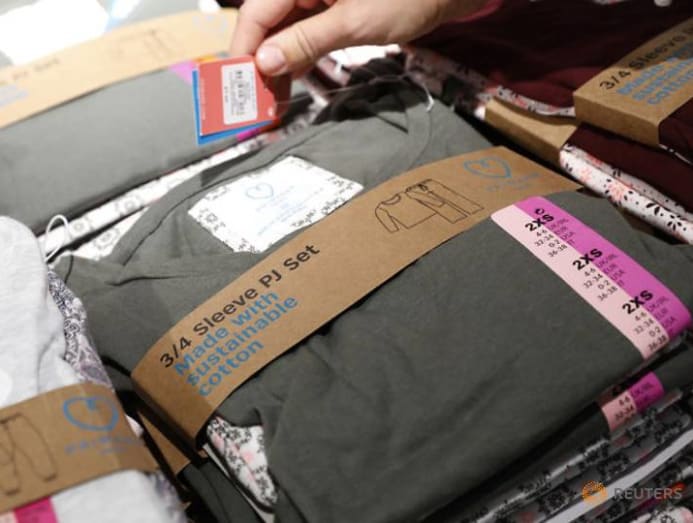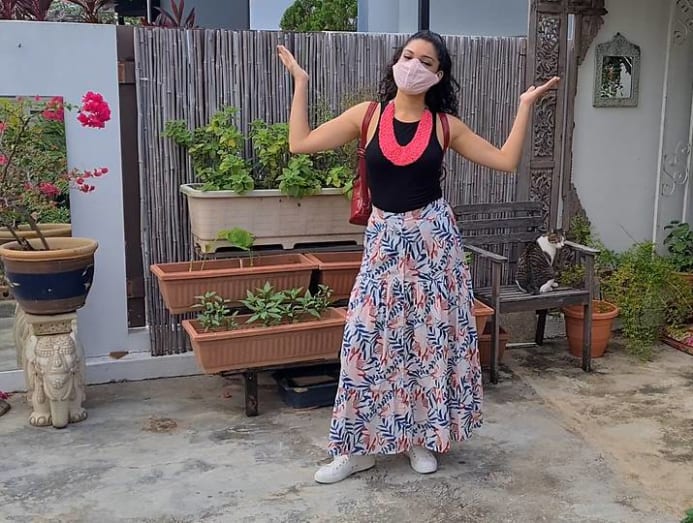The true cost of demand for cheap clothes, to you and the environment
Advertisement
CNA Insider
The true cost of need for cheap clothes, to you and the environment
It turns out that the style industry produces more than carbon emissions than the airline and shipping industries combined. The programme Talking Point finds out if it is possible to dress affordably and more sustainably also.

Workers in Singapore sorting through second-hand habiliment to be exported.
15 Apr 2022 06:30AM (Updated: 17 Apr 2022 11:35AM)
SINGAPORE: These are items Singaporeans can go more cheaply now than 10 years ago.
In fact, clothing prices have fallen to their everyman in a decade, according to the Consumer Price Index for terminal yr — thank you to an explosion of retailers, including Zalora and Pomelo, competing on online platforms since 2010.
With prices going from as depression every bit Southward$3 to S$15 for trendy wearing apparel, Singapore'southward e-commerce revenue from apparel and footwear jumped more than eightfold betwixt 2022 and last year, from S$52 meg to South$442 million.
Simply fast manner comes at a cost: The mode industry released ii.1 billion tonnes of carbon emissions in 2018, according to McKinsey — more than the airline and shipping industries combined (900 million and ane.1 billion tonnes respectively).

Is there a happy rest between bargain hunting and saving the environment? Or is the price of cheap fashion greater than people expect? The programme Talking Betoken investigates.
IT'S THE SUPPLY Concatenation
One cistron in fast fashion'south prices is volume of production. Some "mega" e-commerce retailers tin can release between 500 and 1,000 items per category every calendar week, said MDIS School of Mode and Design lecturer Kae Hana.
A top tin can be designed, produced and marketed then quickly that e-commerce has made way become even faster, "and it'south at present called ultra-fast fashion".
In this business concern model, retailers kickoff find a trending mode and create designs in small batches to test demand. If sufficient demand arises, more of those successful designs are produced to capture sales.

This can be done in double-quick time because of vertical integration in the supply concatenation. "(These e-commerce players) own the product companies … the fabric dyers (and) the logistics companies," she cited.
This process, from concept to sales, takes as fast as two weeks or less. And with consumers "across the world", the more an item is produced, "the cheaper it gets".
The manner industry'southward long supply chain, however, is a reason for its high carbon emissions, said Chu Wong, the country co-ordinator of Fashion Revolution Singapore.
"It starts with the agronomical and the petrochemical industries for the raw materials. It goes on into the manufacturing industry for the fibres to be turned into fabrics and somewhen into vesture," she said.
"It touches the packaging industry (and) logistics industry. Somewhen, information technology gets to the retail industry and to us."

The low prices also lead to overconsumption and overproduction, she said. "Inexpensive manner tempts us as consumers to buy more than because of the accessibility, and and so more is produced. And that's what makes cheap mode so dangerous."
She added that constructed fibres, such as acrylic and nylon, are often used "because they're cheaper" than natural ones. But they "have a higher carbon footprint" — the extraction procedure "is very energy-intensive" equally they are oil-based fibres.
ECO-FRIENDLY AND INEXPENSIVE?
The more sustainable options include fabrics such equally recycled polyester and Tencel. The latter is derived from wood pulp, usually from the eucalyptus tree.
Simply shoppers can practice more than look at the fabric to observe out how sustainably produced an item of wearable is, brash Susannah Jaffer, the founder of online platform Zerrin, which curates options in sustainable style.

"Natural materials, like linen, Tencel (and) bamboo, are definitely more sustainable … considering (they're) biodegradable (at the) finish-of-life," she said.
Only you need to go a little bit deeper … read labels, do enquiry on brands. Also, look at how much information they're sharing.
Sustainable clothing is not all that meliorate for the environment either. For example, recycled polyester is made from recycled plastic and polyethylene terephthalate bottles simply is not biodegradable, she cited.
"When it comes to organic cotton fiber, it uses less pesticides when it's produced. Even so, information technology nevertheless takes ii,700 litres of h2o to produce an organic cotton fiber T-shirt … the same as it would a traditional cotton T-shirt," she added.
"That'due south more than than we'd drink in two and a half years."
Usually, sustainable clothes are more than expensive owing to their production methods and are produced in fewer numbers than those fabricated from more conventional fabrics.

And that higher cost is the main barrier stopping Singaporeans from buying sustainable clothes, co-ordinate to a DBS "witting fashion" survey in 2019.
Jaffer said many fast-fashion brands are able to produce cheaper wearing apparel in their "sustainable capsule collections" considering they still produce "over 90 per cent of their collections through the traditional fast-style model".
"It's not possible (to have sustainable fashion at cheap prices) because yous have to think nigh the additional costs of production, for better quality materials," she added. "That could cost (sustainable brands) 50 per cent, 60 per cent more than."
Cost VS QUALITY
Despite the college price tags, clothes made from sustainable materials are often more cost-effective in the long run.
Spotter: Capsule wardrobe challenge: I survived on five article of clothing items for ten days (9:04)
When Talking Point put apparel made from dissimilar fabrics — including bamboo, cotton, linen, polyester and Tencel — through washing, comfort and durability tests, Tencel clothes retained their colours and shapes better later 30 washes, compared to cotton and polyester clothes.
Inexpensive dress are suitable for brusk-term wear, after which many Singaporeans would donate or discard them.
According to a CNA report in 2018, however, only almost 10 per cent of the apparel given to the Salvation Regular army, for case, are sold in its thrift shops, while the remaining 90 per cent are exported.
Sentinel: Recycling in Singapore: What will it have to bring the numbers upward?
Daro Tan, a manager at SNI Trading, which has been exporting second-hand textiles for more than 10 years, said many of the clothes information technology receives become mainly to countries like Indonesia, Malaysia, Philippines and S Africa.

He said exporting used wearable for reuse is more suitable than recycling, equally each piece of habiliment may comprise many materials, making recycling "also fourth dimension-consuming" and manpower-intensive.
Import restrictions in other countries, even so, are making things more difficult for his visitor. These countries, he said, want to focus on their domestic clothing industries instead of depending on imports.
Since 2018, tighter import restrictions have led to a 40 per cent drib in Singapore'due south 2nd-hand article of clothing exports. In 2019, of the 168,000 tonnes of textile and leather waste matter generated here, just four per cent was recycled, i.e. exported.
The rest ended up being incinerated. "Information technology's really a huge waste," said Tan.
So what can be done to solve the problem of buying and throwing away cheap clothing to the detriment of the environment?
Spotter: The full episode — Our love for cheap clothes: What'southward the true cost? (23:54)
"Perhaps less is more," said Talking Bespeak host Sharda Harrison, who created four unlike looks for herself from the same black outfit past, for example, combining it with jeans and different accessories.
"With a scrap of creativity, I can modify up my way with wearing apparel I already take and exercise my little part in saving our planet."
Watch this episode of Talking Betoken here. The programme airs on Channel five every Thursday at 9.30pm.

Source: https://cnalifestyle.channelnewsasia.com/cna-insider/true-cost-demand-cheap-clothes-you-and-environment-294791
Post a Comment for "The true cost of demand for cheap clothes, to you and the environment"